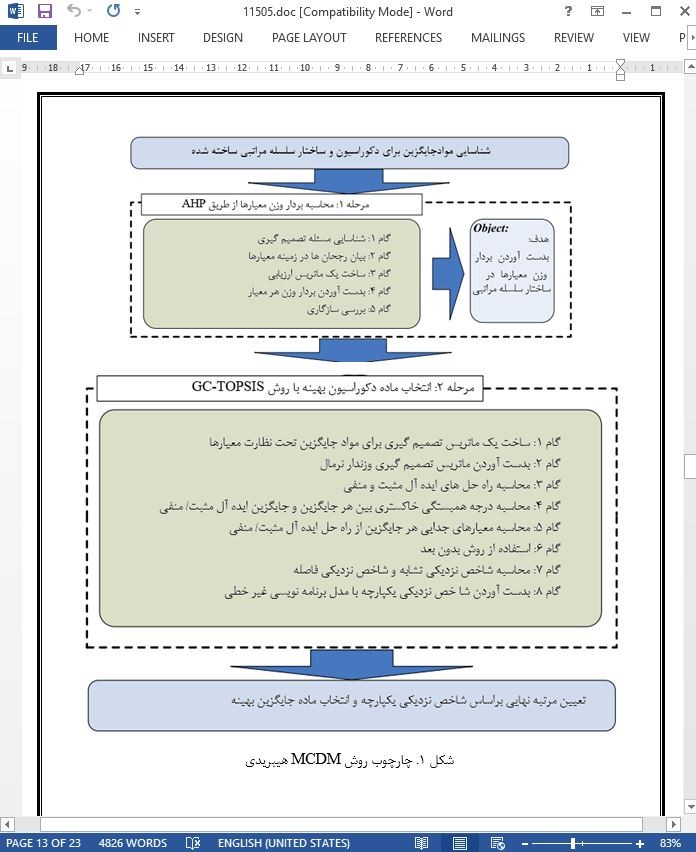
انتخاب مواد دکوراسیون سبز تحت ویژگیهای محیط داخلی:
چکیده
انتخاب مواد، به عنوان یک پیوند ضروری برای موسسات تولیدی، پتانسیل ارتقاء خصوصیات و عمر مفید مواد به ویژه در فیلدهای ساختمانی و دکوراسیون را دارد. برای تعیین کمی مواد بهینه جهت دکوراسیون سبز ، شیوه تصمیم گیری چند معیاره هیبریدی (MCDM) مرکب از فرایند تحلیل سلسله مراتبی (AHP) و تکنیک همبستگی سبز برای عملکرد سفارش براساس تشابه به راه حل ایده آل(GC-TOPSIS) پیشنهاد شده است. بردار وزن ساختار شاخص سلسله مراتبی، که براساس ویژگیهای محیط داخلی به عبارتی راحتی فیزیولوژیکی، رضایت روانی، و اثر محیط داخلی، ترسیم شده است، با AHP تعیین شده است. از GC-TOPSIS برای دستیابی به رتبه بندی نهایی مواد دکوراسیون سبز و انتخاب مواد بهینه استفاده شده است. برای اعتبارگذاری روش پیشنهادی، یک مطالعه موردی، به عبارتی، 10 نوع چوب های جامد شرح داده شده است. به علاوه، برای نظارت براستواری رتبه بندی راه حل در برابر تغییرات، حساسیت 9 آزمایش مورد تجزیه و تحلیل قرار گرفت. نتایج بدست آمده ثابت کرد که این روش، یک ابزار پشتیبانی از تصمیم منطقی و کارآمد برای ارزیابی عملکرد مواد دکوراسیون سبز ارائه می دهد.
1. مقدمه
انتخاب مواد، در کل فرایند طراحی و تولید کاربردهای متنوع مهندسی، نقش مهمی ایفا کرده و در سالهای اخیر توجه بسیاری از محققین را به خود جلب کرده است [5-1]. انتخاب نادرست مواد، بر عملکرد و عمر مفید محصولات تاثیرمنفی گذاشته و حتی منجر به هزینه های زیاد مشارکت و نهایتاً کهنگی پیش رس محصولات می گردد [6]. تحقیقات فعلی راجع به انتخاب مواد را می توان در سه موضوع اصلی جمع بندی نمود: ساخت یک ساختار سلسله مراتبی مطلوب مبتنی بر اصول و معیارهای مختلف، اولویت بندی و تخصیص وزن به معیارهای مربوطه، و فرایند ارزیابی هر ماده جایگزین. به عنوان یک استراتژی مهم در سیستم صنعتی، در فیلدهای مختلف، به ویژه درفیلدهای ساختمان و دکوراسیون استفاده شده است.
5. نتایج
انتخاب ماده بهینه برای دکوراسیون سبز برای فیلد ساختمانی سخت و دشوار و محدود است. این مقاله یک ساختار سلسله مراتبی با ویژگیهای محیط داخلی، به عبارتی فیزیک معماری دیداری، آکوستیک، بساوایی، بویایی و جسم زنده بیان و شیوه MCDM هیبریدی مبتنی بر همبستگی خاکستری متشکل از AHP، GC و TOPSIS برای مقابله با عیوب و کمبودهای یک روش مطرح نمود. در اینجا یکی از کارهای تجربی 10 نوع چوب جامد شرح داده شد. نتایج مقایسه با روشهای موجود، صحت و قابلیت اطمینان (پایایی) شیوه هیبریدی پیشنهادی را تصدیق نمود. به علاوه، تحقیق راجع به تحلیل حساسیت نشان داد که دستیابی به وزن هر معیار به شکلی مطلوب و علمی، نقش مهمی در انتخاب ماده سبز بهینه ایفا می کند. بنابراین شیوه MCDM هیبریدی مبتنی بر همبستگی خاکستری، ابزاری موثر و درست برای انتخاب مواد دکوراسیون سبز محسوب می شود.
Abstract
Materials selection, as a essential link for manufacturing enterprises, has an important driving-force to comprehensively upgrade material properties and service life, especially in building and decoration fields. To qualitatively select the optimal green decoration materials, a hybrid multi-criteria decision making (MCDM) approach integrating analytical hierarchy process (AHP) and grey correlation technique for order performance by similarity to ideal solution (GC-TOPSIS) is proposed. The weights vector of hierarchical index structure, which is established based on interior environmental characteristics, i.e., physiological comfort, psychological satisfaction and interior environmental effect, is determined by AHP. GC-TOPSIS is applied to obtain the final ranking of green decoration materials to select the optimal one. A case study, i.e., 10 kinds of solid woods, is illustrated to validate the proposed method. Additionally, a sensitivity analysis of nine experiments is carried out to monitor the robustness of solution ranking to changes. The results proved that this method furnishes an rational and efficient decision support tool for performance assessment of green decoration materials.
1. Introduction
Material selection plays a significant role in the entire design and manufacturing process for diverse engineering applications, and it has attracted many researchers in recent years [1–5]. Improper selection of materials may negatively affect the performance and service life of products, even result in enormous cost of involvement and ultimately drive towards premature component/product obsolescence [6]. Current materials selection researches can be summed up in three major issues: construct a reasonable hierarchical structure based on various principles/criteria, prioritize and assign weights to relevant criteria, and assessment process of each material alternative. As an important strategy in the industrial system, it has been applied to various fields, especially in building and decoration fields [7,8].
5. Conclusions
Selecting the optimal green decoration material is a difficult and restrained task for the building field. This paper formulated a hierarchical structure with interior environment characteristics, i.e., visual, acoustic, tactile, olfactory architectural physics and living body, and presented a grey-correlation based hybrid MCDM approach that integrates AHP, GC and TOPSIS to handle the defects and deficiencies of single method. An empirical application of 10 kinds of solid woods was illustrated. The results of comparison with existing methods validated the accuracy and reliability for the proposed hybrid approach. In addition, the research of sensitivity analysis revealed that obtaining the weight of each criterion reasonably and scientifically plays a significant role in the selection of the optimal green material. Therefore, this grey-correlation based hybrid MCDM approach is an effective and accurate tool for green decoration materials selection.
چکیده
1. مقدمه
2. مروری بر ادبیات
3. روش MCDM هیبریدی مبتنی بر همبستگی خاکستری
1. 3. شیوه AHP
3. 3 فرایند ارزیابی یکپارچه برای انتخاب مواد دکوراسیون
4. مثال تجربی
1. 4 پیشینه
2. 4 تعیین بردار وزن معیارها براساس شیوه AHP
3. 4. ارزیابی عملکرد سبز مواد دکوراسیون سبز
4. 4 مقایسه نتایج بدست آمده
5. 4. تحلیل حساسیت
5. نتایج
ABSTRACT
1. Introduction
2. Literature review
3. A grey-correlation based hybrid MCDM method
3.1. AHP approach
3.2. GC-TOPSIS approach
3.3. The integrated assessment process for decoration material selection
4. Empirical example
4.1. Background
4.2. Determination of the weights vector of criteria based on AHP approach
4.3. Evaluation of green decoration materials’ green performance
4.4. Comparison of the obtained results
4.5. Sensitivity analysis
5. Conclusions
- ترجمه فارسی مقاله با فرمت ورد (word) با قابلیت ویرایش، بدون آرم سایت ای ترجمه
- ترجمه فارسی مقاله با فرمت pdf، بدون آرم سایت ای ترجمه



